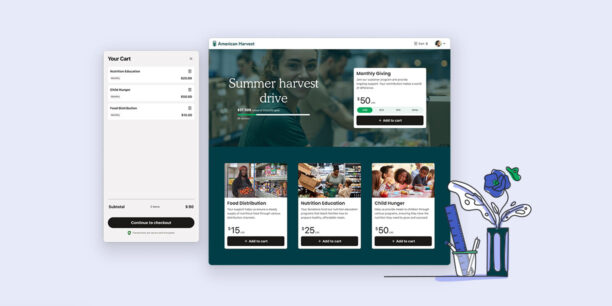The Essential Role of a Modern Data Stack in Next-Generation Nonprofit Giving

Request a Demo
Learn how top nonprofits use Classy to power their fundraising.
This blog was written in collaboration with Alexandra Wilson, Business Intelligence Lead, and Sam Heckendorf, Data Scientist, of Classy’s Data Science and Analytics team.
Before data science and AI-saturated news feeds, data was only accessible through Excel spreadsheets, a simple query to an Access database, and, dare we say, green-bar paper.
Data requests were queued neatly in an analyst’s inbox, and an ad-hoc pivot table or deftly crafted VLOOKUP could typically meet most demands. Although this era had its advantages, it also contributed to some common difficulties organizations face today, including siloed data, disparate systems, and inconsistent reporting.
Fortunately, for every end user who has asked themselves, “Why don’t these numbers match?” the modern data stack holds the answers and clarity we need. Data teams no longer need to rely on manual methods and can instead embrace automation, advanced analytics, and cloud-based technologies to streamline their data use cases.
Here, we’ll outline nonprofits’ common data pitfalls and share our hard-earned insights on effectively navigating data complexities with a modern data stack. Most importantly, we’ll define the unparalleled value of intelligence-driven philanthropy and how curating a modern data stack is the first step in ushering your organization into the new era of giving.
Data Pitfalls Challenging Today’s Nonprofits
If you’ve ever received multiple Giving Tuesday reports, you may have wondered why the total donation amounts varied. While inconsistent reporting can be frustrating, it doesn’t imply bad data quality. Instead, it highlights the need for uniform reporting methods throughout the organization.
This includes aligning time zones, defining a true donation, and setting up protocols for offline gifts. These simple steps can help stakeholders get on the same page and improve organizational data literacy.
Additionally, siloed systems can be one of the most challenging pitfalls within any organization. Without a single source of data truth, you risk sharing inconsistent external messaging, damaging brand recognition, or even communicating based on outdated or inaccurate information. Plus, it’s impossible to confidently make strategic decisions if you’re uncertain about which data sources to rely on.
The abundance of data available to modern organizations presents another potential challenge. New, efficient data storage and collection tools have simplified introducing new data to your reports and workflows. Although storage advancements are undoubtedly beneficial, these can inadvertently lead thriving data lakes to become stagnant data swamps if lacking the proper data governance.
Together, these challenges create barriers to critical nonprofit practices, like segmentation, calculating donor lifetime value, defining donor acquisition costs, and, most importantly, initiating and nurturing meaningful relationships with supporters.
Without the information required to understand your donors and cultivate those lasting connections, nonprofits are left with raw data, lacking the insights to contribute to true data intelligence.
Defining and Emerging through the Data Maturity Model
It’s crucial to acknowledge that every nonprofit organization embarks on a unique data journey, with their understanding and access to data integrations and systems developing over time at different rates.

Data may feel new for organizations at the most basic, foundational stage. Basic data practices at this level typically involve rudimentary collection and storage, often lacking a comprehensive strategy or single source of truth.
As your comfort level and knowledge increase, you’ll likely begin standardizing data access and reporting, defining concrete strategies and visions, and forming a data science team to help you identify emerging trends and patterns.
At the highest level, data will become central to your organizational strategy, allowing you to forecast and make accurate predictions, offer intelligent recommendations leveraging AI/machine learning, and optimize data processing practices for efficiency and accuracy.
Continual learning and progression through the stages of data maturity are crucial for several reasons:
1. As organizations advance in data maturity levels, they enhance their capacity to collect, analyze, and derive meaningful insights. For instance, with detailed donor profiles encompassing preferences, engagement history, and giving patterns, organizations can strategically tailor fundraising appeals and giving on-ramps, leading to more personalized and effective donor interactions.
2. A mature data infrastructure enables organizations to understand their impact, optimize resource allocation, and identify opportunities for growth or improvement. Suppose a nonprofit runs an education program. Using data allows the organization to identify its most effective program components, such as specific curriculum elements or teaching methodologies. This detailed insight lets them focus on what works best, ensuring that donor investments yield maximum impact.
3. By reaching a stage where data informs all decisions, nonprofits can operate with heightened efficiency and amplify their impact on the causes they champion. Consider a nonprofit focused on environmental conservation using data analytics to optimize outreach efforts. Analyzing engagement patterns from various communication channels helps them identify the most effective platforms and messaging strategies to raise awareness and garner support. This data-driven approach streamlines operations and maximizes their influence.
Provided every nonprofit’s goal is to reach the highest level of data maturity, a modern, reliable data stack is the foundation to achieve it.
The Modern Data Stack: What It Is and Why It’s Important
At its core, the modern data stack ensures effective, secure, and efficient data collection, storage, processing, and management. Data collection begins the moment you check your feed, add tickets to your cart, or click on a donation site.
This seamless integration of user-friendly interfaces is a web of sophisticated algorithms capturing donors’ interactions, preferences, and behaviors. Every click, search, and transaction powers the raw data that will provide valuable metrics to your organization.
However, these measurements don’t come in the form of neatly curated dashboards but rather a hodgepodge of data sources that require thorough cleaning and data transformation to unveil meaningful patterns and valuable observations.
Revolutionizing Data Management
Thankfully, what was once a timely and tedious process has advanced light-years thanks to the evolution of the modern data stack and its impact on data infrastructure and job function.
What used to be a manual engineering exercise of writing custom code to extract data from one source (think Salesforce, Google Analytics, and Mailchimp) into a cloud data warehouse (think Amazon Redshift and Snowflake) is now available via off-the-shelf data pipeline tools, like Fivetran and Stitch.
Engineers and analysts have streamlined task hand-off as tools like Data Build Tool have simplified SQL collaboration across roles and consolidated job responsibilities under the analytics engineering umbrella.
Additionally, implementing a semantic layer provides a unified framework for data interpretation and usage across various data platforms. This means less time spent reproducing results and more time strengthening the bond between nonprofit stakeholders and self-service business intelligence tools.
Tools such as Looker and Thoughtspot are critical in achieving these time savings. Behind the scenes of each executive dashboard is a complex set of high-powered data models thoughtfully and meticulously weaved together across multiple sources.
Reverse extract, transform, load (ETL) tools like Census have also alleviated process ambiguity between data teams and internal domains, giving nontechnical users the power to harness curated data models. This means fewer offline spreadsheets because donor data is now available in one centralized customer relationship management platform.
Gear Up to Launch Your Stack
In the context of data management, the principle of buy over build becomes increasingly relevant. The emergence of off-the-shelf data extraction tools, the low costs of storage, and the growing number of self-service analytics tools allow nonprofit organizations to integrate with ease and manage large datasets with minimal technical expertise.
In an environment where data is abundant, the key to activating the right insights isn’t just gathering the data but identifying the relevant insights for decision-making.
While new on-ramps for giving are always a key part of nonprofits’ digital strategies, more organizations see recurring donors and community cultivation as the foundation for fundraising. To steward donors and build those relationships, clean data accessible across all departments is key. This ensures that whoever pulls a report operates off the same baseline and that disparate data doesn’t derail the organization’s strategy.
In the coming weeks, we’ll delve deeper into these themes on our blog, offering practical recommendations on how nonprofits can proactively combat the most significant data pitfalls and emphasize why the shift toward intelligence will remain critical through 2024 and beyond.
We aim to equip organizations with actionable insights to navigate the evolving landscape of data management, ensuring they’re well-prepared and set up for fundraising success. Stay tuned for a comprehensive exploration of strategies and best practices that will empower your nonprofit to harness the full potential of its data capabilities.
Classy’s Agile Data Team and Integrations
At Classy, we harness the power of the modern data stack to support every organization in driving its mission home. Our advanced ETL tools enable us to ingest data across multiple sources, build scalable data models, and power the real-time insights we deliver to our fundraisers.
Additionally, our agile data team brings a robust set of skills to the table, blending data engineering with business intelligence and AI/machine learning. More than just analysts and engineers, we’re problem-solvers and storytellers who harness the power of data to craft meaningful insights carefully.
Recognizing how integral data is in serving the thousands of nonprofits leveraging Classy’s fundraising platform, we’re committed to delivering the right tools, integrations, and partnerships to help nonprofits confidently make data-informed decisions.
With a reinvigorated commitment to building the deepest integrations for the sector, we are excited about the future of integrations. Our integrations into the Salesforce ecosystem, including Nonprofit Success Pack and Nonprofit Cloud, empower organizations to do more with their data.
In addition to Salesforce, our comprehensive integrations library, including Google Analytics 4, Zapier, Omatic, and more, seamlessly connects diverse data sources and systems, empowering organizations with a unified, comprehensive view that drives lasting impact.
Learn more about our integrations.
Copy Editor: Ayanna Julien

Explore Classy's Integration Library
Subscribe to the Classy Blog
Get the latest fundraising tips, trends, and ideas in your inbox.
Thank you for subscribing
You signed up for emails from Classy
Request a Demo
Learn how top nonprofits use Classy to power their fundraising.
 Explore Classy.org
Explore Classy.org 

